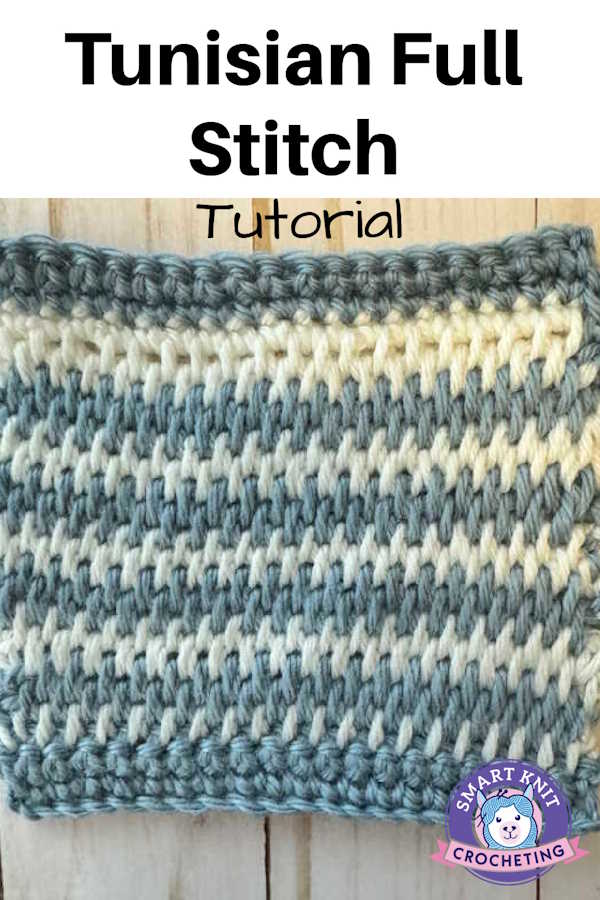- Home
- Crochet Stitches
- Tunisian Full Stitch
Tunisian Full Stitch
Tunisian Full Stitch
Tunisian crochet, also known as Afghan crochet, is a unique hybrid of traditional crochet techniques. It uses long hook, often with a stopper on one end, to create a fabric that resembles knitted fabric.
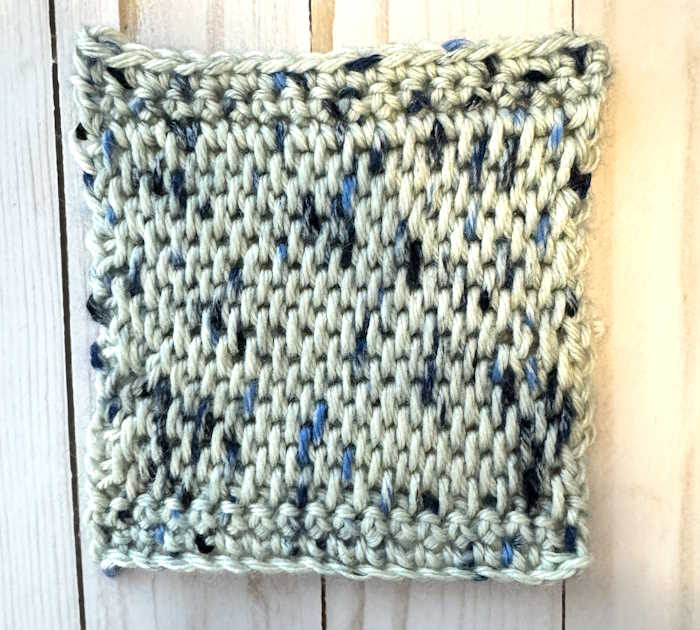
Tunisian Two-step Process
Tunisian crochet is worked in two stages: the forward pass, where loops are picked up and remain on the hook, and the return pass, where the loops are worked off the hook.
This process creates a dense, slightly stretchy fabric that is perfect for a variety of projects, from blankets and scarves to sweaters and accessories.
The Tunisian full stitch (abbreviated TFS) differs from other Tunisian stitches because you insert the hook between the two vertical bars of each stitch from the previous row.
The woven look to the fabric is achieved by alternating where you insert your hook. On the first forward pass row, the hook is inserted in the first space created by the vertical bars, and then at the end of the row, you skip the last space and work directly into the edge stitch. The second forward pass is worked by skipping the first space and working directly into the second space.
If this doesn't make sense, don't worry, I'll explain.
Supplies You Will Need
- Tunisian crochet hook
- Yarn
- Scissors
- Tapestry needle
TIP
Since the fabric is thick and dense, I recommend you chose a Tunisian crochet hook that is one or two sizes larger than you would for the weight of yarn you are using.
So, for example if you are working with a worsted weight yarn that might normally require a size H (5.0 mm) hook, you might try a 5.5 mm or a 6.0 mm for Tunisian Crochet
Basic Tunisian Crochet Concepts
There are two parts to creating Tunisian crochet fabric after the initial chain and set up row,
- Forward pass
- Return pass
Tunisian Full Stitch Tutorial
Step 1
Create a foundation chain of any number of stitches. The number of chains you begin with will be the same as the number of Tunisian full stitches on the hook.
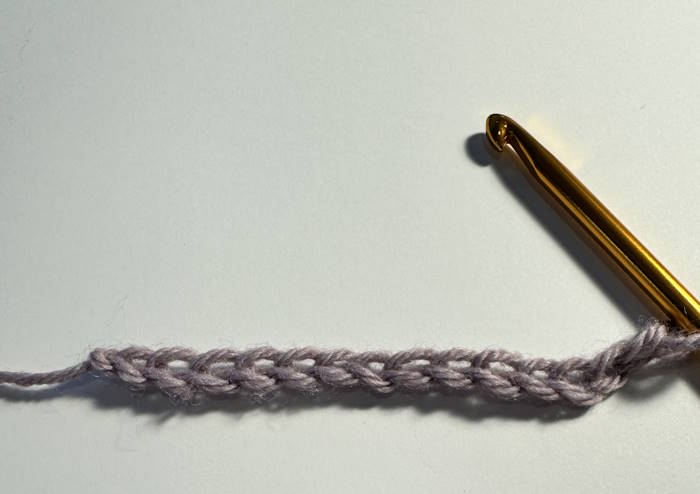
Step 2: Set-up Pass
Insert your hook into the second chain from the hook, yarn over and pull up a loop. Leave the loop on the hook. Continue across the chain until all of the chains have been placed on the hook.
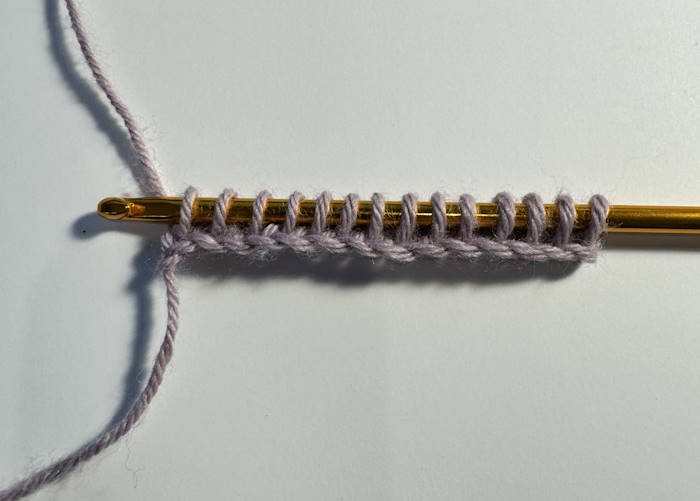
Step 3: Set-up Return Pass
Yarn over and pull through the first loop on the hook. Then, yarn over and pull through the next two loops on the hook. Continue across the row by yarning over and pulling through two loops at a time. One loop is left on the hook.
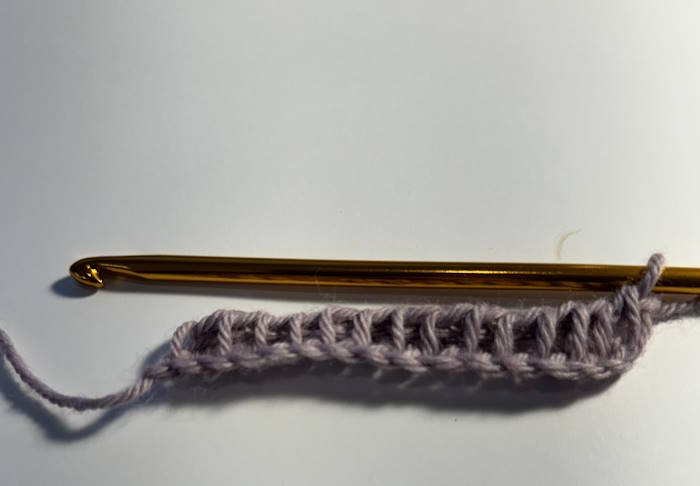
Step 4: First Forward Pass
Insert the hook into the first space, yarn over and pull up a loop. Continue across the row until you reach the last space. Skip the last space and insert the hook into the edge stitch and pull up a loop.

Step 5: Return Pass (always the same)
Return Pass (this is the same as we just did)
Yarn over and pull through the first loop on the hook. Then, yarn over and pull through the next two loops on the hook. Continue across the row by yarning over and pulling through two loops at a time. One loop is left on the hook.
Step 6: Second Forward Pass
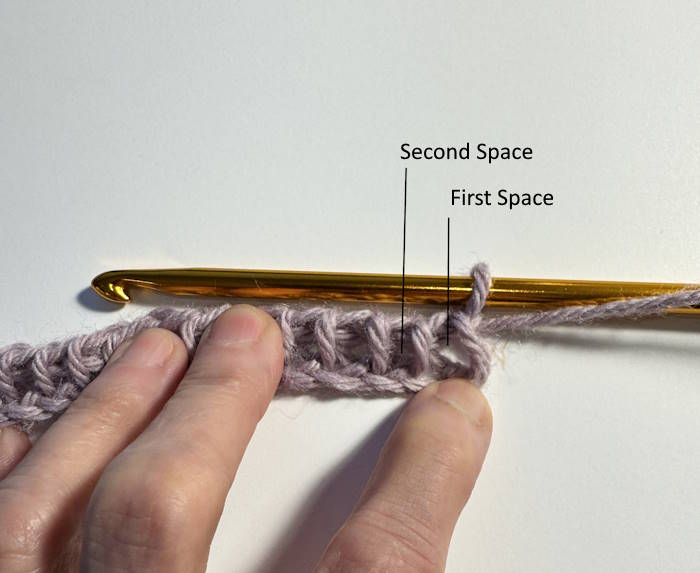 Skip the first space created between vertical bars and insert the hook into the second space.
Skip the first space created between vertical bars and insert the hook into the second space.This is similar to the one above, except you will skip the first space created between vertical bars and insert the hook into the second space.
Work across in this manner until you reach the end of the row. Unlike the last forward pass, you will insert your hook into the last space and pull up a loop.
Finish by inserting your hook into the edge stitch, yarn over and pull up a loop. You should have the same number of stitches as previously.
Step 7: Return Pass: Same
Repeat the instructions above for the return pass
Repeat steps 4 through 7 until you reach your desired length, then bind off.
Quick Reminders:
- If you go into the first space on the forward pass, skip the last space at the end of the row.
- If you skip the first space, work into the last space at the end of the row.
- Count your stitches to assure you maintain the same number of stitches in each row.
Tips for Making the Tunisian Full Stitch
Is you fabric curling? It is very common for this type of technique to curl, and blocking will help. One method for stopping it from curling from the beginning is to work your first row or two in single crochet stitches, then begin the Tunisian stitch pattern. This may help a little.
Another suggestion, that I mentioned previously is to use a larger size hook.
Keeping the loops loose on your hook also helps.
Where do you insert the hook? To make it easier to see where to place the hook, pull up the loops a little higher than you normally would when crocheting normally.
Uneven Edge Stitches? This may not be an issue if you plan to sew the edges, but if you are making a scarf or something else that must look good on either side, tension issues on the edges can be a big problem.
Ask me how I know!
Tension can be an issue, so when you pull up loops to place on the hook, be sure they are all the same height. Also, it's a good idea to tighten the yarn slightly before beginning your forward pass and make sure your last stitch of the row is not too tight.
How to Bind off the Tunisian Full Stitch
The bind off row is done on the forward pass and should be loose. Continue to maintain the pattern you established above.
Insert your hook in the appropriate space, yarn over and pull through (slip stitch). Continue across the row. Fasten off and weave your ends.
Variations: Tunisian Full Stitch in Two Colors

It's not difficult to make a two-color variation for this stitch.
Row one is worked in Color A (remember that each row contains a forward and return pass)
Row two is worked in color B
Row Three: Color B
Row Four and Five: Color A
Repeat this pattern of working two rows in one color and then the next two rows in a contrasting color.
Carry the unused color up the side of the fabric so you have fewer ends to weave in.
Work until you reach your desired length, ending with Color A for a balanced design. Bind off with the slip stitch method, described above with color A.
Conclusion
The Tunisian full stitch is one of many Tunisian stitches that combines elements of both crochet and knitting and results in a unique and beautiful fabric.
The thick dense fabric is perfect from cozy blankets home décor to wearables such as sweaters. The stitch looks eloquent in either a simple color or add some color for a unique design.
Remember to start slowly, focusing on maintaining even tension, neat edges and accurate stitch counts. If you start with 15 stitches, you must maintain 15 stitches, otherwise your rectangular fabric will be misshapen
Whether you're a beginner looking to expand your crochet skills or an experienced crafter seeking a fresh challenge, the Tunisian Full Stitch is a valuable addition to your repertoire.
Grab your hook and yarn and let's crochet!
Janice
References and Further Help
I like to keep stitch dictionaries around and how-to books that I find helpful. Here are a couple books I can recommend.
Tunisian Crochet Stitch Dictionary: 150 Essential Stitches with Actual-Size Swatches
Also, I highly recommend Toni Lipsey from TL Yarn Craft's Tunisian Crochet Videos on YouTube
Tunisian Full Stitch: Pin for Later
About Janice
I've been kniting and crocheting since childhood, but never got serious until about 4 years ago. Taking classes, reading books, and most importantly, practicing, I've gained an understanding of how one might struggle when learning to knit or crochet.
Now, I'm on a mission to help others learn how to knit and crochet, and to love these needlearts as much as I do. More about Janice.
